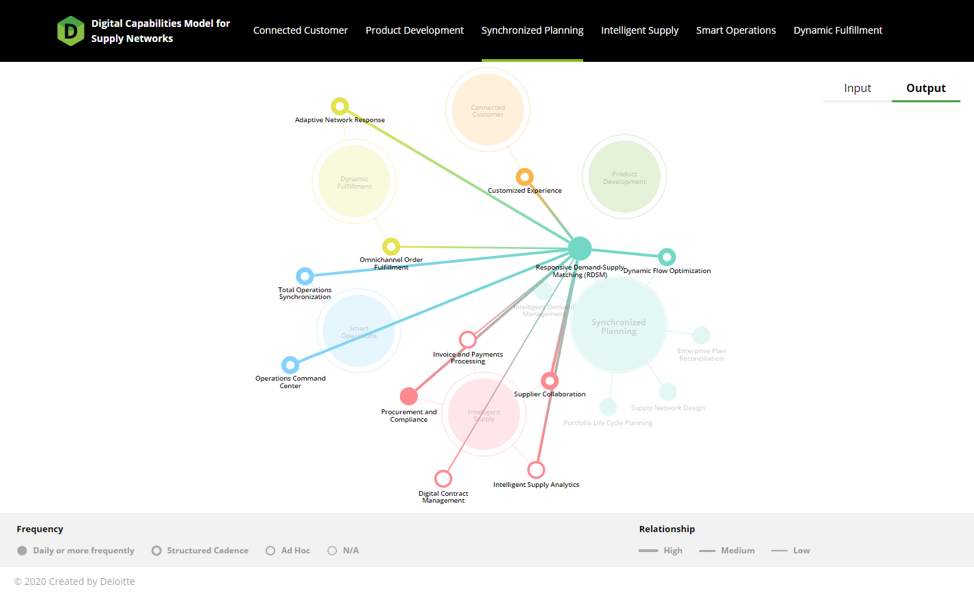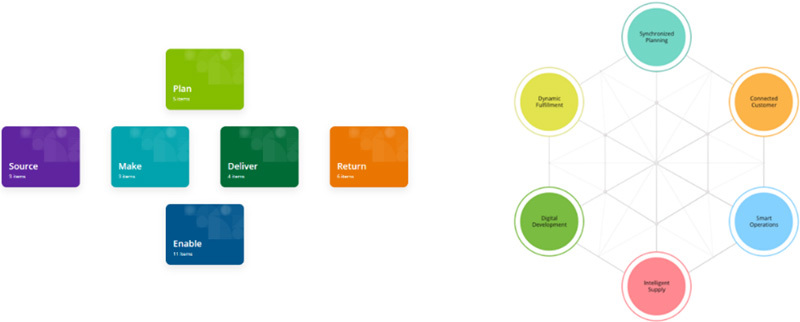New Capabilities-Focused Reference Model Aims to Accelerate Digital Supply Chain Transformations
By Morgan Swink and Jeroen Kusters
When the Supply Chain Operational Reference (SCOR) model was introduced in 1996, it truly revolutionized the practice of supply chain management. The SCOR plan-source-make-deliver framework provided a method for businesses, big and small, to align functions, create a supply chain roadmap and measure and manage processes from “the supplier’s supplier to the customer’s customer.” But our world was very different back then. The World Wide Web was in its infancy. Amazon.com was a start-up online book dealer, and Google was still two years from being founded.
Today, decision support technologies leveraging big data, intelligent algorithms, and machine learning are improving the insight, quality and speed of planning and decision making. Process automation of all types, including sensors, robotics and software, is making operations more consistent, cheaper and “always-on.” Integrative communications technologies create platforms that are connecting intra-firm processes and personnel to customers and suppliers in collaborative and real-time interactions. While SCOR’s foundational process elements have been extended through the years, technological innovations such as 3D printing and sensor-driven replenishment have put pressure on this linear paradigm. Many supply chain leaders are increasingly finding that SCOR, while intuitive and useful, does not fully address the defining aspects of today’s digitally enabled environment.
“SCOR, while intuitive and useful, does not fully address the defining aspects of today’s digitally enabled environment.”
Recognizing the need for a new model that better addresses the intricacies of next-generation, digital supply chain operations, thought leaders at Deloitte and the Association of Supply Chain Management (ASCM), supported by members of an academic advisory board, developed a new “Digital Capabilities Model for Supply Networks” (Figure 1). This DCM framework is inherently connected to SCOR in that it builds upon SCOR’s functional organization of process elements. However, the DCM is designed to embody more directly the digitally transformed nature of supply network processes, including the concepts of concurrent planning and sensor-driven responsiveness, which connect global business networks today.

Settling the SCOR
Figure 2 summarizes key differences between SCOR and the DCM. Where the SCOR model is designed around traditionally linear supply chains, through a hierarchical decomposition of process steps, DCM is organized around a network of capabilities. DCM capabilities are the symbiotic combination of people, process, technology and data required to perform a business function, moving beyond the traditional process-centric thinking.
DCM is composed of 6 “level 1” capabilities. These extend the traditional scope of SCOR by including product development and allowing companies to augment foundational transactional interactions by integrating effective customer engagement throughout the customer, product and service life cycles, from acquisition to service.
Network thinking, central to the DCM model, breaks the conventional hierarchical decomposition model and highlights the need for concurrent processes and active connections between 38 “level 2” digital capabilities. Digital concepts form the core of the DCM. They emphasize the needed shift from a traditional input-process-output control system towards the digital disciplines of “Sense-Collaborate-Optimize-Respond.” This shift underscores the agility in digital supply networks needed to respond to an increasingly uncertain environment.

| Reference Model | SCOR | DCM |
|---|---|---|
| Paradigm | Supply Chain | Digital Supply Networks |
| Organizing Structure | Hierarchical: Decomposition | Relational: Digital Chords |
| Model Orientation | Process: Definition | Capability: Fit and Maturity |
| End-to-End Orientation | Sequential Transactions | Concurrent Collaborations |
| Control Systems | Input-Process-Output | Sense-Collaborate-Optimize-Respond |
| Technology Role | Implement Leading Practices | Transform Leading Practices |
Where SCOR focuses on implementing leading practices, harvested through the ASCM community over several decades, DCM is intended to be more forward looking and transformative. DCM has been thoughtfully designed to provide supply chain professionals with an abundance of information from the definition, vision, capability journey maps and personas associated with each capability, making it possible to incorporate the elements of digital supply network thinking in supply chain transformations.
Enabling Flux Capacity
At the core of the DCM development effort was a consensus that in order to coherently sort through the myriad of technology-enabled opportunities to form strategic roadmaps for change, supply chain leaders need a more holistic and strategic view of supply chain management. While process thinking remains an important vehicle for defining input-output relationships that structure a supply chain, a focus on capabilities provides a more stable and strategic way of capitalizing on technology-enabled opportunities and maximizing the longer-term paybacks from investments and innovations, even as processes and technologies are in constant flux.
Articulating supply chain strategy and growth plans in terms of capabilities enables clearer linkages to overall business strategies and clarifies ways that the supply chain will provide value to its customers, while differentiating itself from competitors. With this approach, supply chain managers can transcend the “either/or” tradeoffs between responsiveness and efficiency that frustrates so many professionals, and prioritize responsiveness and resilience, while continuously improving efficiency and reliability.
Network thinking is expressed in the DCM through three key characteristics: it is connected, always-on and transparent. In our view, connectivity is the most defining aspect of a supply network, as it defines the engagement between the functions in the organization. For example, enabling immediate response to manufacturing disruptions, as well as outside the organization, providing real-time feedback from connected customers to product development. Always-on supply networks align with customer expectations, i.e., letting consumers search and order products any time with immediate and accurate order confirmation. Finally, transparency helps organizations operate more efficiently. Supply chain inefficiency is most often the product of the guessing game many practitioners are unwittingly forced to play. Guessing if a customer will place more or fewer orders in the next period, guessing if the factory will have adequate capacity to manufacture those orders, guessing whether or not suppliers will be able to deliver materials in time to prevent a lines-down situation.
To achieve network thinking, digital enablement can no longer be an afterthought. Real-time responsive digital supply networks are only possible through a symbiotic combination, and optimization, of people, process and technology. Digital supply network thinking requires a paradigm change towards digitally enabled capabilities as the building blocks of the supply chain operating model, as opposed to the traditional process-focused approach where processes are first designed, then subsequently automated or buttressed using technology.
“Digital supply network thinking requires a paradigm change towards digitally enabled capabilities as the building blocks of the supply chain operating model.”
In order to make the capabilities paradigm come to life, the DCM also introduces the concept of digital chords (Figure 3). Each digital chord guides the user through the digital capabilities model to address a particular business challenge. These examples provide starting points for supply chain managers to apply the DCM to real-life business challenges and to understand the impacts that connected capabilities have in contributing to a solution.

Since the DCM was first released in 2019, we continue to update and revise it to incorporate the latest digital supply network concepts. Too often supply chain managers respond to immediate pain points by acquiring an expensive technology solution, rather than proactively working to optimize their developmental investments in their unique resources, skills, relationships and technologies. Our goal is to continue to provide more depth by documenting the strength and rationale of the connections in the model. By adding connectivity to metrics for all the capabilities, DCM can become a beacon of innovative, capability-based supply network thinking and help more organizations reach beyond the low hanging fruit of process automation.
DCM can help more organizations reach beyond the low hanging fruit of process automation.
As enterprise leaders begin or advance their digital capabilities journey, they should remember that digital transformation is as much of an organizational challenge as it is a technological one. So often we hear supply chain leaders say that it is the people element of the people-process-technology foundation for capability thinking that is the most challenging to master. Organizational hierarchies and reporting relationships are often out of sync with newer process models that are either technology-based or enabled. For example, some layers of organizational overhead may no longer be necessary, while new support structures might need to be created.
Transforming a supply chain to a capabilities-based, digitally enabled competitive weapon will require managers who are both technologically savvy and willing to embrace new ways of thinking, which is why we strongly recommend that in addition to scanning the landscape for emerging technologies, supply chain leaders should also carefully consider the changing talent requirements needed to successfully implement and maximally exploit technological opportunities.
Related Resources:
- Fact Sheet: Digital Capabilities Model for Supply Networks
- Gartner: Digital Transformation Playbook for Supply Chains
- Article: Defeating Digital Change Fatigue
- White Paper: Building Resilient Supply Chains: What Past Experiences Taught Us About Gaining Advantage in the Current Recession
- Book: Inventory Planning and Optimization with SAP IBP
